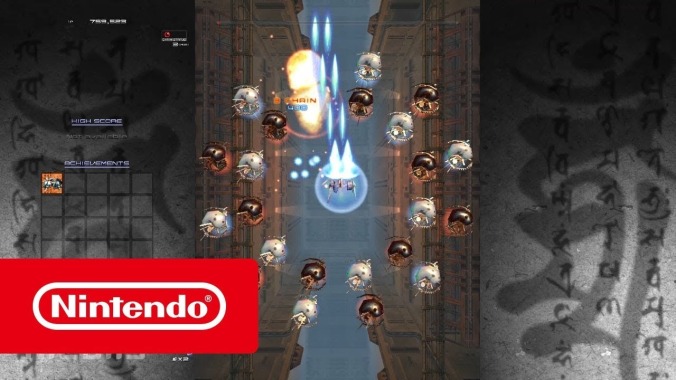Ikaruga on the Switch is a perfect introduction to the beauty of bullet-hell games

Every Friday, A.V. Club staffers kick off our weekly open thread for the discussion of gaming plans and recent gaming glories, but of course, the real action is down in the comments, where we invite you to answer our eternal question: What Are You Playing This Weekend?
Ikaruga
I’ve always been drawn to bullet-hell shooters, if only because of their name. Is there a phrase in gaming more darkly apt? The platonic ideal of a bullet-hell shooter is an endless rain of multicolored bullets through which the player bobs and weaves, not only via laser-quick reflexes but also brutal memorization. The best of them—often made by the Japanese developer Treasure—frequently couch these levels within absolutely impenetrable, surrealist narratives, with all the scope and philosophical splendor of a good JRPG but only a fraction of the run-time. They’re gonzo, hard-as-hell, and beautiful. I’m utter shit at them.
Most bullet-hell shooters let you scale things down to baby mode, so you can see the sights and watch the cut scenes if need be, but unlike many other genres, something always feels lost when you do this here. Should “hell” ever be easy? Thankfully, Ikaruga is never easy, no matter which settings you tweak. The game is one of Treasure’s last major works, originally released in 2001 in Japanese arcades and ported reverently to new systems every few years since. It’s a singular document of Treasure’s design ethos. The studio found new ways to remix the bullet-hell format with each new game, and by the time they got to Ikaruga, they were pretty much on Neptune, with a polarity-switching mechanic that inspires both white-knuckle flying and brain-wracking puzzles, and a vertical orientation that means you’re only playing on the center stripe of your TV screen. Its five terse levels can be beaten in about 25 minutes if you know what you’re doing, but first you’ve got to unscrew the levels in your head and then maddeningly wind your way through them, sucking in some bullets and repelling others.
I’ve been banging my head against this gnarled-up death vortex for years, each time determined to best it with finality. It’s now found a new home on Nintendo’s Switch, and, like everything else on the planet, it’s a perfect fit for the platform, eating up your TV set with bi-chromatic bullets and fitting nicely in your hand for quick practice runs. (You can also break off the Joy-Cons for easy two-player action.) All of which begs a question: Should everything just be ported to the Switch? It’s become home to an endless string of ports—sedate gardeners like Stardew Valley, sprawling RPGs like Skyrim, metal-as-fuck brawlers like Bayonetta, not to mention Mario Kart and Donkey Kong Country and so on—and all feel weirdly maximized by the system’s singular design. Ikaruga is still Ikaruga—nothing could alter this singular beast—but even it feels refreshed by the Switch’s eager-to-please adaptability. Even if you’re not a bullet-hell person, it’s a definitive title to slot into your rotation on the system. [Clayton Purdom]
Street Fighter 30th Anniversary Collection
If you’ve kept up with the site at all, you already know I’m a huge fan of fighting games. Besides their fun, colorful rosters, what I love most about them is the learning process each one presents: a chance to dive into something completely unfamiliar and slowly piece the peculiarities together. As academic as that sounds, it’s honestly one of my single favorite things to do in all of games. Give me a new fighter, point me in the direction of the training mode, and I’ll be happy to just sit there for hours experimenting. It also means I won’t ever get especially good at any one game, since I tend to bounce from title to title, learning the basics and moving on, forever a scrub.
Never is my own suckitude more obvious than when I boot up any Street Fighter game released between SF2 and SF4. This year is the series’ 30th anniversary, and one way Capcom is celebrating is with a new anthology that packs in almost every version of Street Fighter II, Alpha, and III, alongside the primordial original and a mountain of bonus features. (I’ll have more to say about that another day, but for now, just know that the archivists at Digital Eclipse have done an incredible job unearthing and packaging tons of ancillary material. You could, and I have, spend hours sifting through it all.) I’ve been spending the most time with Alpha and SF3, as they’re the ones I’m least familiar with. I’m also so unspeakably terrible at them, partially because of that unfamiliarity but also because they hail from a long experimental period where Capcom was glomming all sorts of ideas onto the Street Fighter II frame work. For a layman like me, there’s just so much more to grapple with, but I persist. The suffering is just part of the fun, after all. And hey, it’s not like I’m trying to play these games online, which looks like its own special kind of hell. [Matt Gerardi]